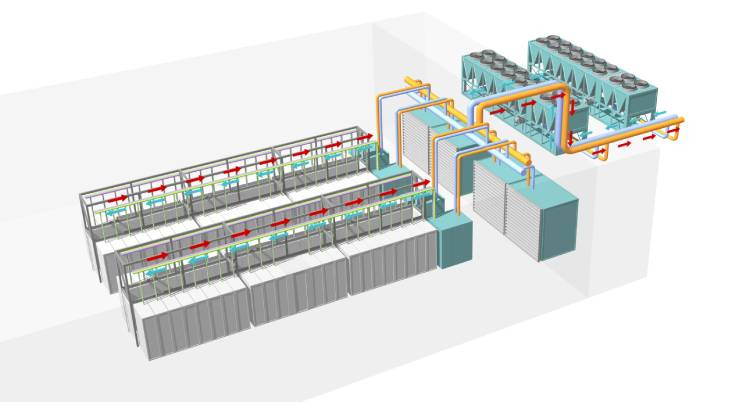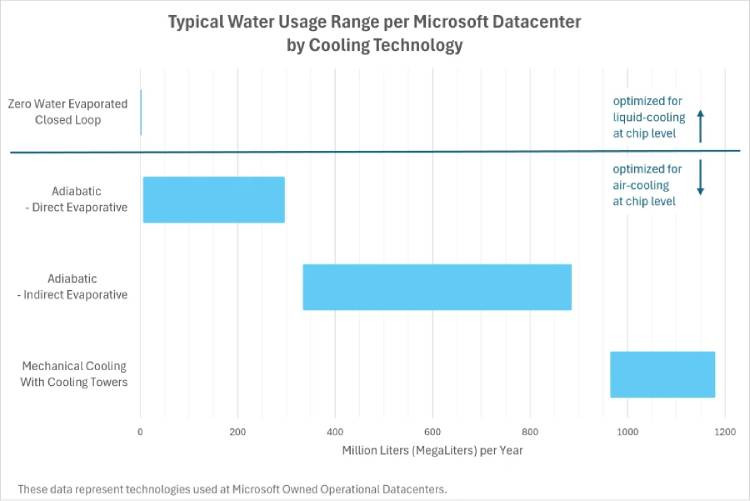Microsoft's Zero-Water Datacenters Lead Sustainable Innovation
Insights | 06-01-2025 | By Robin Mitchell

The increasing demand for cloud computing and data storage has led to a substantial rise in the construction of data centers, which greatly impacts the environment. Data centers consume massive amounts of energy, often sourced from non-renewable resources. However, beyond energy consumption, the amount of water used to cool these facilities is another major environmental concern.
Key Things to Know:
- Microsoft's next-generation datacenter design introduces chip-level cooling solutions, eliminating the need for water in cooling operations, significantly reducing environmental impact.
- The zero-water evaporative cooling system operates on a closed-loop design, conserving freshwater resources while optimising energy efficiency for AI workloads.
- Microsoft aims to achieve near-zero Water Usage Effectiveness (WUE) across its datacenters, aligning with global sustainability goals and reducing operational risks in water-stressed regions.
- While this innovative cooling technology offers significant environmental benefits, challenges such as energy consumption and risk of server damage require continuous technological refinement.
What challenges do data centers present, how will Microsoft's new design help to address these issues, and could this new method be key to making data centers more environmentally friendly?
The Challenges of Datacenter Cooling
Data centers are the unsung heroes of the digital age, providing the backbone for cloud computing and artificial intelligence technologies that have reshaped the way we live and work. With the increasing demand for online services and data processing, the importance of data centers cannot be exaggerated.
However, the massive energy requirements of these facilities pose a crucial challenge, particularly for those who prioritise environmental sustainability. The energy crisis faced by data centers is a pressing concern, with many builders struggling to meet the power demands of their facilities.
Some have even resorted to exploring unconventional energy sources, such as nuclear power, to ensure a reliable and consistent supply of electricity. While this approach may address the issue of power availability, it does not address the environmental impact of data centers.
The Environmental Consequences of Energy Use
Environmentalists have long been critical of the energy consumption patterns of data centers, which are often linked to non-renewable sources. The use of air conditioning systems to cool these facilities requires additional energy, which is frequently sourced from fossil fuels.
This not only contributes to greenhouse gas emissions but also perpetuates the reliance on non-renewable energy sources. Furthermore, the use of air conditioning systems in data centers can lead to increased energy consumption, which in turn exacerbates the environmental impact of these facilities.
Water cooling is another method employed by some data centers to manage their temperature. While this approach may seem more environmentally friendly, it poses its own set of challenges.
Impact on Local Ecosystems
The large quantities of water required for cooling can have devastating effects on local ecosystems. The discharge of heated water into nearby water sources can disrupt the natural balance of aquatic life, leading to the degradation of water quality and potentially harming local wildlife.
Additionally, the consumption of water for cooling purposes can put a strain on local water resources, particularly in areas where water scarcity is already a pressing issue. Evaporative cooling is another technique used by some data centers to mitigate the effects of heat generation.
However, this method also has its drawbacks. The evaporation of water to cool down equipment results in the loss of water, which is not replenished by the data center.
This can lead to the drying up of nearby rivers and water sources, resulting in arid landscapes and exacerbating environmental degradation. The use of evaporative cooling also requires substantial amounts of energy to operate, which can further contribute to the environmental impact of data centers.
Microsoft's New Datacenter Cooling Technology Revealed
Recently, Microsoft announced the launch of its next-generation datacenter design that utilises chip-level cooling solutions to optimise AI workloads while consuming zero water for cooling.
Microsoft's focus on chip-level cooling solutions not only aligns with environmental sustainability but also directly addresses the increasing demand for high-performance data infrastructure. This innovation could significantly influence industry standards for resource-efficient technology development.
Sustainability and Water Conservation Efforts
The advanced design, which has been in development since 2024, marks a crucial shift in the data center industry, establishing a new standard for sustainability and efficiency.
According to Steve Solomon, Vice President of Datacenter Infrastructure Engineering at Microsoft, the new design will help protect local watersheds, particularly in areas where water stress is a growing concern. The zero-water evaporative cooling system recycles water through a closed-loop system, eliminating the need for freshwater supplies and reducing the risk of water contamination.
Piloting Zero-Water Cooling Technology Worldwide
By transitioning to a closed-loop system, Microsoft not only conserves freshwater resources but also reduces operational risks associated with water scarcity in regions where datacenters are critical to local digital infrastructure.
The new design has been piloted in several datacenters around the world, with the first sites expected to come online in late 2027.
Microsoft's Commitment to Community Impact
This design stands as a major step towards aligning large-scale data operations with global sustainability goals, balancing technological advancement with environmental responsibility.
While the design has been met with excitement from the tech industry, it also presents a crucial opportunity for Microsoft to reduce its environmental footprint and contribute to a more sustainable future.
"Protecting local watersheds is an important part of our data community pledge, and we are committed to making a positive impact on the communities in which we operate," said Solomon. "Our new datacenter design is a crucial step toward achieving this goal, and we look forward to continuing our efforts to reduce our environmental impact."
Improving Water Usage Effectiveness (WUE)
Solomon’s emphasis on environmental responsibility reflects Microsoft's broader sustainability strategy, including efforts to reduce carbon emissions and improve global water conservation metrics.
The new design is also expected to improve Microsoft's Water Usage Effectiveness (WUE) by 39% compared to its previous generation of data centers.
Achieving a lower Water Usage Effectiveness (WUE) not only reduces water dependency but also positions Microsoft as a benchmark for eco-conscious data management within the tech industry.
The WUE measures the total annual water consumption for humidification and cooling divided by the total energy consumption for IT equipment.

Energy Efficiency and Mechanical Cooling
Microsoft's goal is to reduce its WUE to near zero for each datac enter that employs zero-water evaporation, which will help further reduce its fleetwide WUE. In addition to the new data center design, Microsoft is also working to mitigate the energy impacts of the shift to mechanical cooling.
This commitment towards minimising WUE aligns with global sustainability standards, potentially setting new benchmarks for how hyperscale datacenters address water conservation.
The company is exploring advanced solutions to reduce power consumption, including the use of high-efficiency economising chillers with elevated water temperatures.
Microsoft's Long-Term Sustainability Vision
This advancement in cooling technology reinforces Microsoft's proactive approach towards reducing the environmental impact of its cloud services, balancing technological growth with climate-conscious innovation.
The launch of the new datacenter design marks a vital milestone in Microsoft's path toward sustainability.
The company has been working to reduce its environmental impact since the early 2000s, achieving an 80% reduction in water use compared to its first generation of datacenters. With the introduction of the zero-water evaporative cooling system, Microsoft is poised to continue its commitment to sustainability and environmental stewardship.
By integrating zero-water cooling technology at scale, Microsoft demonstrates leadership in sustainable infrastructure, paving the way for a new era of eco-efficient data management solutions.
Will Such Technologies Help Change the Future of Data Processing?
Despite the many advantages of closed-loop cooling systems, they are not without their challenges.
One of the primary concerns is the need for chip-level cooling. As server processors continue to shrink in size and generate increasingly high temperatures, it becomes essential to have a cooling system that can target individual chips. This requires a network of tiny pipes and heat exchangers that can be integrated into the server design, adding complexity and cost to the overall system.
Risk of Equipment Damage and Downtime
Another challenge faced by closed-loop cooling systems is the risk of damage to server racks. Any issues with the water lines, such as leaks or blockages, can cause catastrophic damage to the servers, resulting in costly repairs and downtime. The high value of server equipment makes it essential to ensure that the cooling system is reliable and fault-tolerant, which can be a notable design challenge.
Additionally, closed-loop cooling systems may also suffer from challenges with needing additional energy to cool water without evaporating it. This process can be energy-intensive, as it requires mechanical refrigeration or other methods to lower the water temperature, which can increase the overall energy consumption of the system.
The Importance of Renewable Energy Integration
If the energy used to power the cooling system is not sourced responsibly, it can negate the environmental benefits of the system. For example, if the energy is generated from fossil fuels, it can contribute to greenhouse gas emissions and climate change. On the other hand, if the energy is sourced from renewable sources such as solar or wind, it can help reduce the overall carbon footprint of the data center.
Overall, closed-loop cooling systems show great promise for reducing the environmental impact of data centers, but they are not without their challenges. The need for chip-level cooling, the risk of damage to server racks, and the energy consumption of the cooling system all present crucial design challenges that must be addressed. However, if these challenges can be overcome, closed-loop cooling systems could play a critical role in the transition to a more sustainable data center industry.

